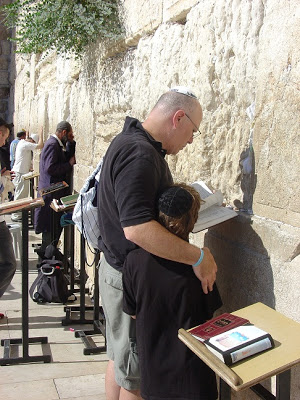This coming Saturday evening, May 28th, through sunset on Sunday the 29th, is the holiday of Yom Yerushalayim (Jerusalem Day). Jerusalem Day is the anniversary of the day, during the Six-Day War in 1967, the IDF retook Jerusalem. For the first time since 1948, the sacred city of Jerusalem was united.
On a trip to Jerusalem, I found irrefutable evidence that the Temple Mount is Jewish. But before I get to the evidence, allow me to provide some background on the Temple and Temple Mount.
For approximately 1,900 years (since 135 CE), the Jewish people have ached to return to their eternal capital. As it says in Psalm 137:
“If I forget you, O Jerusalem, may my right hand forget its skill. May my tongue cling to my palate, if I do not remember you if I do not bring up Jerusalem at the beginning of my joy.”
For over a thousand years, a Jewish Temple to G-d stood atop the Temple Mount. The reason modern places for Jewish worship are calledT\ Synagogues is the belief that only the building atop Mount Moriah is a temple-another example of the Jew’s attachment to the holy Temple.
The Temple Mount (Mount Moriah) was purchased by King David approximately ten centuries ago. Although the seller (Araunah) offered David a discount, the King insisted on paying the full price. David’s history was deemed too bloody to build a Temple to G-d. But David’s son, Solomon, was allowed to build the Temple atop the Mount.
Solomon’s Temple stood from approximately 966-586 BCE when it was destroyed by Babylonian invaders, and the Judeans (Jews) were exiled to Babylon. About 50 years later, the Persians defeated and took over Babylon. Soon the Persian King Cyrus told the Jews to go home and rebuild their Temple.
The Second Temple was rebuilt 70 years after the first was destroyed;. The Second Temple rose around 516 BCE. It wasn’t as magnificent as the first one. Almost 500 years later, approximately 20 BCE, Herod the Great, who was controlled by Rome, upgraded the Temple and expanded the Temple Mount. It wasn’t for reasons of faith. It was an attempt to gain acceptance from the Judeans who did not trust him.
The Romans destroyed that Temple in 70 CE., and the Jewish nation was exiled from their land in 135 CE after another attempt to defeat the Romans and regain control of their eternal homeland.
The wall or the Kotel (Hebrew for wall), also known as the Wailing Wall or Western Wall, is not part of the Holy Temple. It is part of the retaining wall for the ‘Temple Mount.
Today Muslims claim the Temple Mount is theirs, and there was never a Jewish Temple on top of Mount Moriah. Most European countries deny the Temple Mount’s Jewish heritage also. However, any claim the Temple Mount is anything but Jewish is merely propaganda. The propaganda ignores that ancient Greeks, Romans, Christians, and even ancient Muslims reported Jerusalem and the Temple Mount were the property of the Jewish people.
In this post, I’m not going to argue historical facts. Nor will I discuss history or tradition. I won’t argue whether Mount Moriah hosted two Jewish Temples to G-d because I’ve been there.
As corny as it may sound to people who were never there, I felt the presence of G-d at the Kotel. I didn’t get to go to the top of the Mount because Jews aren’t allowed to pray there (long story), but I did get to pray at the Kotel.
All my life, I had an overwhelming desire to go to Jerusalem, especially the Temple Mount. I never understood that urge until I joined my family in Jerusalem. lt was our first trip to Israel.
Before going to Jerusalem, our guide took us north to Haifa, Tzvat, and Israel’s borders with Lebanon and Syria. At the borders, I had the opportunity to take pictures of the demarcation lines between Israel and her enemies and emailed the images to my long-suffering mom of blessed memory, who couldn’t sleep because of the fright;
When we finally approached Jerusalem, it was from the north. As soon as we drove through the hills, I got a peek at Jerusalem, and for the first time in my life, I felt strangely comfortable in my surroundings.
Jerusalem felt like home to me, even though I had never been there. Strangely I knew where to go and how to get around this holy city without looking at a map. Sometimes, I would tell my family that I had a shortcut to get to where we needed to go. My wife would tell me I was crazy (which is entirely true but irrelevant). My directions/shortcuts were always correct–perhaps because I had read so much about the city, maybe it was something else. Everywhere we went in the holy city, I knew where we were and its relation to the Temple Mount. The closer we got to Mount Moriah, the lure of the Temple Mount became stronger.
Now, anyone reading this who has never been to Israel is probably calling for the guys in white coats to bring me one of those lovely jackets–you know, the ones with very long sleeves that tie in the back so they could drag me away peacefully. But before you make that call, ask anyone who has been there (anyone who believes in G-d) and see if their feelings were any different than mine.
On our second day in Jerusalem, we were finally going to the Kotel. With rare exceptions, the retaining wall is the closest any Jewish or Christian tourist can get to the Temple Mount (For those who get to the top of the Mount— no praying is allowed for non-Muslims). That law was created by the Israeli Government in an attempt to keep the peace with Muslims.
The whole family got up early, and I packed up my Tallit (prayer shawl), Siddur (prayer book), and T’fillin (small black leather boxes containing scrolls of parchment inscribed with verses from the Torah attached to straps and worn by Jews during daytime prayers). We took off with our guide into the Old City. Yossi, our fantastic guide, built up the anticipation by taking us all over the Old City. He knew how important going to the Kotel was to me, yet instead of going directly to it, he teased me with, “It’s right over that wall. We will see this movie first, or let’s go to the burnt house, etc.” I was frustrated, but he was masterfully building up my expectations. Finally, we walked down the wooden stairway and walked through the gate of the Kotel Plaza, and I was overwhelmed by emotions that I had never felt before.
All my life, I felt a longing to go to the Kotel, and I finally knew why. You see, everywhere else you go in Israel, you can sense the presence of all that had gone on before you, King David, Abraham, the 12 tribes, the two kingdoms, and on and on. It’s about culture and history. But when you visit Jerusalem, especially as you get close to Mount Moriah, it is all about G-d. It is about being able to feel the lingering remnant of the Shekhinah (God’s presence) that left Mount Moriah just before the first Temple was destroyed by Babylon,
At the Kotel, I learned that the dispute over who owns the Temple Mount was all political. It is all about delegitimizing the Jewish presence in Jerusalem. No one had to say it–I was there. And with my son, then ten years old, holding my davening bag., I celebrated my lifelong dream. I wrapped one of the T’fillin around my arm, placed the other on my head –wrapped my Tallit around my son and me, and prayed to our maker–starting with the Shehechayanu prayer, which is said to say thanks for any new occasion. The English translation of the one-line prayer is Blessed are You, Lord our G-d, King of the Universe, who has granted us life, sustained us, and enabled us to reach this occasion.

I continued with the afternoon prayers I had recited hundreds of times before, but it was different this time. It felt like more than just praying at the Kotel. Those words of Hebrew seemed to have meaning like never before. I was connecting with the G-d of Abraham, Isaac, and Jacob.
That’s when I realized that “urge” I had felt all my life wasn’t an urge…it was an invitation from my maker, “Come visit so we can talk where it’s a local call.” And while I know that God is everywhere, for some reason only a Rabbi can explain, his presence is much stronger in Jerusalem and even stronger near the Temple Mount.
THERE! That’s it, that’s my proof, that’s how I know that the Temple Mount is Jewish. Nothing scientific, nothing that will work in a court of law or an international dispute. It’s all about faith. I felt a powerful connection to the Lord at the Kotel. There is not another place in the entire world that could come close. Where did that connection originate? Maybe it’s something in the DNA of a Jew that acts as a homing device. Just like a compass, it always points to Jerusalem
As it is said, Israel is the heart of the Jewish people, Jerusalem is the heart of Israel, and Mount Moriah is the heart of Jerusalem.





















Join the conversation!
We have no tolerance for comments containing violence, racism, vulgarity, profanity, all caps, or discourteous behavior. Thank you for partnering with us to maintain a courteous and useful public environment where we can engage in reasonable discourse.